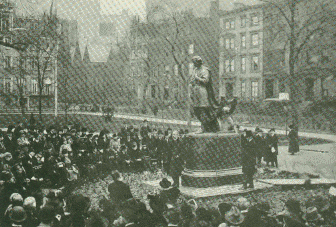 IN the silver haze of a November noon the art of the stage was honored by an event that was unique in New York. The first statue erected to an actor in the world's metropolis was unveiled in Gramercy Park. It was America's manner of knighting Edwin Booth.
IN the silver haze of a November noon the art of the stage was honored by an event that was unique in New York. The first statue erected to an actor in the world's metropolis was unveiled in Gramercy Park. It was America's manner of knighting Edwin Booth.
It seemed to the half a thousand persons who had gathered from far and near corners of Manhattan to do reverence to the memory of the foremost American actor that the little enfenced green oblong was a spot of sentiment in a wilderness of commerce. It was a place where one pauses to remember, and is not interrupted by his recollections. The statue, life-size, stands conspicuously among the trees, their comrade yet dominating them. Almost directly across the street is the gracious gray facade of the house that was Edwin's Booth home and which he gave to his own profession.
The sculptor, who had won the competition among members of the Players' Club for the perpetuation in stone of the memory of its founder, reveals Booth in his gentlest mood. The head is mildly bowed. The features are relaxed in a meditative smile. The posture is that meditative one, in which he began the classic soliloquy as Hamlet. His daughter Edwina Booth Grossman, sat on a rustic seat at his feet. His grandson, Edwin Booth Grossman lifted his son, the actor's infant great grandson, in his arms, to look at the smiling bronze.
At a signal Guy Nichols, the well-known and popular librarian of the Players who, when an actor, had played with Booth, drew aside the wrapping as a stage curtain parts. That moment the sun came forth, shone for an instant on the graceful bronze, and withdrew for the day.
Howard Kyle, Secretary of the Edwin Booth Memorial Committee, turning to John Drew, President of the Players, said:
"My dear Mr. President, it is with a sense of deep gratitude that we meet you at the base of this finished memorial, designed to perpetuate the memory of our common benefactor, a great actor, the enchantment of whose art is still an abiding inspiration in our lives. The committee, speaking for the united membership of the club, whose voluntary contributions have met the cost entailed, have the honor to ask that The Players now accept a clear title to this monument, free from encumbrance, and assume faithfully the duty of its care and preservation.
"Honored sir, on this the anniversary of his birth, the memorial to Edwin Booth is now ready to be unveiled."
Mr. Drew made reply:
"Mr. Secretary, from the poet to whose genius Edwin Booth dedicated his great powers of interpretation I may well take my cue today. You remember that line in The Merchant of Venice, 'Such harmony is in immortal souls.' Out of the immortal memory of Edwin Booth there has flowed the harmony of many men, working steadily and devotedly together to do honor to his name. Amongst members of the Players, the club which he founded and gave not only to his own profession, but to the other arts, the monument was planned and made possible. Two players fashioned it. The bronze was modeled by the sculptor, Edmond T. Quinn. The pedestal was designed by the architect, Edwin S. Dodge. And that it stands now, amid these trees upon which Booth loved to gaze from the window of his home yonder, is due to the courteous co-operation of the trustees of Gramercy Park, who have sympathized with our project from its beginning."
"An immense good will, my friends, has carried the project to its successful completion. I speak it with feeling. It is as the gift of a company of loyal, loving hearts that I accept, on behalf of the Players, this statue of the noblest Hamlet the American stage has ever produced, our leader and our friend."
John B. Pine's rejoinder was: "The trustees of the park for themselves and those whom they represent cordially welcome the distinguished guest you have brought us and we congratulate you upon the accomplishment of your long cherished wish in the erection of this statue of the great player who for so many years made Gramercy Park his home."
Brander Matthews said: "We may apply to Edwin Booth the praise given to Shakespeare as an actor by a contemporary: 'He was excellent in the quality he professed.' In founding the Players he built himself a monument more enduring than bronze; and now we have set up this enduring bronze, to stand here through the years, and to bear witness that he saw the Players well bestowed."
About the statue in admiring groups stood Robert Mantell, Oliver Dodd Byron, Bruce McRae, Louis Mann, Francis Wilson, Henry B. Stanford, Agnes Arden, widow of Edwin Arden and daughter of Thomas Keene, Daniel Frohman, Laura Burt, Mrs. Suzanne Westford Allen and Miss Laura Sedgwick Collins.
Purchase Books about Edwin Booth